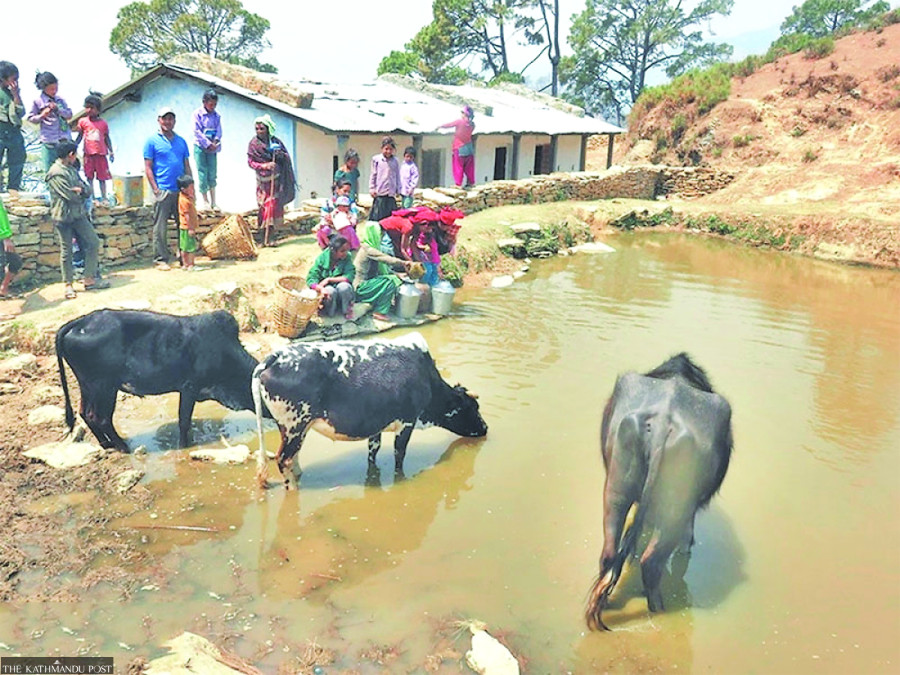Columns
A case for ‘ahals’
We need to reformulate our adaptation policies to address a looming water crisis and its effects.
Madhukar Upadhya
In the last four years, four out of five deep tube wells in the town of Attariya in Kailali district in the Tarai have gone dry. A 30-foot-deep water table has dropped further to a depth of 80 to 120 feet in the last 15 years. Likewise, almost 50 percent of springs in the mountains are drying or disappearing. Many small streams have also stopped flowing except when it rains. These unfolding circumstances have been reported from different parts of Nepal for several years, illustrating a worsening water crisis in the making. Though there are many opinions about why water sources are drying, there is no concrete evidence to help explain the situation. Perhaps a change is occurring on a huge scale that we know very little about; and if that is true, realising an effective solution to the problem would first require a deeper understanding of what is going on.
A recently published synthesis report by the Intergovernmental Panel on Climate Change says that we are going to face a new climate system within this decade if temperatures continue to rise as they have so far. Even under a very low greenhouse gas emission scenario, global temperature is more likely to rise by 1.5 degrees Celsius in the near future. With every additional increment of temperatures, intensification of the global water cycle, including precipitation patterns, becomes unavoidable. We are headed towards increased occurrences of floods and droughts. These changes will not only undermine the progress made so far, but could result in irreversible transformations in the natural world, affecting the very foundation of the systems that support life.
Institutional structures
Globally, experts have been debating whether our current systems of governance and economic organisation are even suited to address the worsening water crisis in a warmer world. This is also true for Nepal; our existing institutional structures were developed long before global warming became an issue, and the pressures on natural resources weren't as high due to lower population density.
Consider the following examples: Institutions mandated to manage water are primarily focused on making provisions to transfer it from sources to consumers for domestic purposes or irrigation. As long as the water is available at these sources, we can build drinking water systems or irrigation canals. They're also involved in drawing groundwater for domestic or agricultural use if it's at a reasonable depth. But it's not within the mandate of these institutions to address drying water sources which has been happening across the country in recent years. Unsurprisingly, no action has been taken at the scale required to address drying springs or depleting groundwater sources by any of the established water institutions, barring some sector-specific or research-level responses covering a small area, which aren't nearly enough to make a difference.
The case of food production is no different. The development of agriculture focused on providing improved seeds, fertilisers and pesticides, among other inputs, ever since planned agriculture began. They have transformed agriculture from subsistence to commercial enterprise for many. Unfortunately, damage to crops caused by weather variability has never been part of conventional agriculture development programmes. Recent cases of such weather-related damage paint an alarming picture of the losses incurred by our farmers and their suffering.
In 2021, we lost ready-to-harvest paddy worth Rs11 billion due to unseasonably heavy rain in October. Similarly, a few weeks ago, untimely rain damaged winter crops at higher elevations. Loss of fertile land to floods and landslides is a recurrent problem. On the other hand, the frequency of winter droughts has dramatically increased since 2000. Occasionally, we've also faced droughts in the middle of the monsoon. Our agricultural institutions fail to consider domestic, traditional solutions that are known to work because of their misguided notion that the answers must lie within modern expertise. Protecting crops from disasters is a lower priority for the agencies responsible for disaster reduction. We must reorganise our existing institutions to protect food crops from disasters and sustain food production in a warmer world with frequent floods and droughts.
Re-writing water policies
Since water remains at the heart of the climate crisis, and attempting to address the interlinked, multi-layered environmental problems, from drought to depleting groundwater to floods, is only possible by making water the focal point, we need to completely re-haul our approach to managing water resources. For instance, rewriting our water policies with the emerging context in mind may help us address the issues in the new climate system, of which we have seen only glimpses. We may believe Nepal is rich in water resources and even have the data to back up the claim. However, in reality, people have had to abandon homes and farms where local sources ran completely dry. We could continue to argue the causes, but what we need aren't explanations lacking sound logic or drawn-out debates. What we need are action-oriented strategies for reviving drying springs and replenishing groundwater reserves. If we are to reverse course on such a colossal crisis, we must begin by addressing the small problems like our vanishing springs.
For this to happen, we need an integrated land, water and climate policy propelled by mission-oriented leadership and collective action at every level. There are numerous examples of our forefathers integrating land and water management to combat our region's skewed monsoon rainfall distribution. Collecting rainwater in small pools called ahal, used for buffalo wallowing, on community-owned land is a tried and tested method of storing water for the drier months as well as a means to replenish groundwater by allowing the water to seep underground—one that has been employed through the centuries. By cutting down the runoff volume, it also helped reduce erosion in the mountains at no additional cost.
Across the world, ancestral, indigenous knowledge regarding the conservation and restoration of environmental resources, particularly water, has already proven to be effective and enduring. No wonder such ahals once peppered our mountains and valleys. Unfortunately, these ahals had been forgotten for several decades. While their importance has once again been realised, the new-generation ponds were built with plastic or concrete lining in an imprudent attempt to modernise them. These artificially-lined ponds won't feed the groundwater like their predecessor, the ahals. If we're serious about addressing our looming water crisis and the myriad cascading issues born of it, we must reformulate our adaptation policies, revive ahals, and prioritise and integrate the conservation of land and water in a warmer world.




 11.12°C Kathmandu
11.12°C Kathmandu















